Purple amaranth, Red amaranth
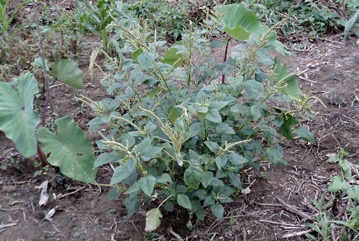
It grows in the tropics and more temperate regions. In the tropics it is mainly in the highlands. In Papua New Guinea it grows best between 1,200 and 2,200 m altitude. It needs a night temperature above 15°C and preferably a day temperatures above 25°C. It is best in fertile, well drained soil. In Argentina it grows between sea level and 1,000 m above sea level. It suits hardiness zones 8-11. In Yunnan.
Also known as:
Adjogodo, Alayyafu, Alefo, Ama, Bathu, Bee kumpeeyu, Bionuda, Biteku teku, Bitembele, Boroboro, Chaulai, Chekoi, Dodo, Doodo, Efan, Efo tete, Fotete, Gango, Grain amaranth, Grins, Hancai, Han ts'oi, Hondi, Inca wheat, Inene, Ka-bonthila, Kitembele, Lalchulai, Lengalenga, Madze, Mangara kunge, Marsa, Mbwembo, Mitembele, Moca, Monzonda, Muotsu, Ngwengu, Nut keerai, Omujuiga, Phatakshii, Rajgira, Rajira, Rana-tampala, Red shank, Seul, Sobue, Swie, Tete, Tetefufu, Tete nla, Thepe, Trator, Tseque, Tshiubavhakololo, Ts'iteli jijlaq'a, Tubua
Synonyms
- Amaranthus hybridus subsp. cruentus (L.) Thell.
- Amaranthus paniculatus L.
- and several others
Edible Portion
- Seeds, Leaves, Vegetable, Flowers
Where does Purple amaranth grow?
Found in: Africa, Argentina, Asia, Australia, Benin, Botswana, Brazil, Burkina Faso, Cameroon, Canada, Caucasus, Central Africa, Central America, Chad, Chile, China, Congo DR, Côte d'Ivoire, Croatia, Dominican Republic, East Africa, Eswatini, Ethiopia, Fiji, Gabon, Georgia, Ghana, Guatemala, Guinea, Guinée, Guyana, Haiti, Himalayas, India, Indochina, Indonesia, Ivory Coast, Jamaica, Kenya, Korea, Laos, Lesotho, Liberia, Malaysia, Mali, Mauritania, Mexico, Mozambique, Nigeria, North America, Pacific, Papua New Guinea, PNG, Philippines, Sao Tome and Principe, SE Asia, Senegal, Sierra Leone, South Africa, Southern Africa, South America, Sri Lanka, Sudan, Swaziland, Uganda, Tanzania, Togo, Turkey, Uganda, United States, West Africa, West Indies, Zambia, Zimbabwe
Notes: Seed (Fresh weight) Protein: 15 %. There are about 60 Amaranthus species. It can help control nematode populations. It is a C4 plant.
Status: It is a commercially cultivated vegetable. It is an important and popular leafy green.
Growing Purple amaranth, Red amaranth
Cultivation: Plants can be grown from seed if the soil is warm. Seeds are small and grow easily. They can be put in a nursery and then transplanted after 2-3 weeks. Cuttings of growing plants root easily.
Edible Uses: The leaves and young plant are eaten cooked. They are also dried and stored. The seeds are ground into flour and used to make bread. The seeds are popped and used to prepare candy. CAUTION: This plant can accumulate nitrates if grown with high nitrogen inorganic fertilisers and these are poisonous. The leaves can only be stored for 2-4 days.
Production: Yields of 800-1500 kg per hectare are achieved. Plants can be harvested by pulling up the entire plant or by removing leaves over several harvests.
Nutrition Info
per 100g edible portion| Edible Part | Energy (kcal) | Protein (g) | Iron (mg) | Vitamin A (ug) | Vitamin c (mg) | Zinc (mg) | % Water |
|---|---|---|---|---|---|---|---|
| Leaves | 42 | 4.6 | 8.9 | - | 64 | - | 84 |
| Leaves | - | 4.5 | 9.2 | - | - | - | 87.1 |
| Roots | - | - | - | - | - | - | |
| Seeds | - | - | - | - | - | - | |
| Seeds | 479 | 14.7 | 3.8 | - | 0 | - | 87.7 |
Purple amaranth, Red amaranth Photos

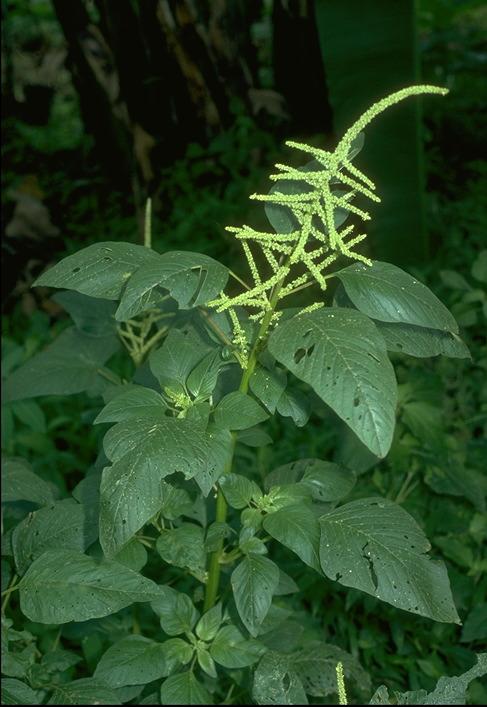
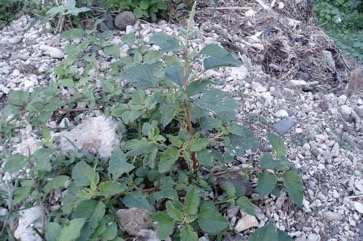
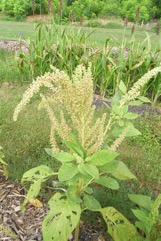
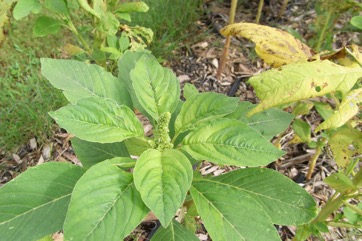
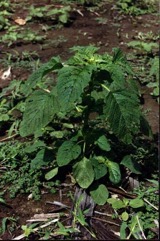
References
Achigan-Dako, E, et al (Eds), 2009, Catalogue of Traditional Vegetables in Benin. International Foundation for Science.
Achigan-Dako, E. G., et al, (Eds.), 2010, Traditional vegetables in Benin. Institut National des Recherches Agricoles du Bénin. Imprimeries du CENAP, Cotonou.
Agea, J. G., et al 2011, Wild and Semi-wild Food Plants of Bunyoro-Kitara Kingdom of Uganda: etc. Environmental Research Journal 5(2) 74-86 (As Amaranthus hybridus subsp. cruentus)
Ambasta S.P. (Ed.), 2000, The Useful Plants of India. CSIR India. p 34 (As Amaranthus paniculatus)
Andabati, B., & Muyonga, J., 2014, Phenolic content and antioxidant activity of selected Ugandian traditional medicinal foods. African Journal of Food Science. 8(8), pp 427-434
Anywar, G., et al, 2014, Wild Plants Used as Nutraceuticals from Nebbi District, Uganda. European Journal of Medicinal Plants 4(6): 641-660, 2014
Bao Bojian; Steve Clemants, Thomas Borsch, Amaranthaceae [Draft], Flora of China
Berihun, T., & Molla, E., 2017, Study on the Diversity and Use of Wild Edible Plants in Bullen District Northwest Ethiopia. Hindawi Journal of Botany.Article ID 8383468
Brickell, C. (Ed.), 1999, The Royal Horticultural Society A-Z Encyclopedia of Garden Plants. Convent Garden Books. p 106
Bussman, R. W. et al, 2017, Ethnobotany of Samtskhe-Javakheti, Sakartvelo (Republic of Georgia), Caucasus. Indian Journal of Traditional Knowledge Vol. 16(1) pp 7-24 (As Amaranthus paniculatus)
Burkill, I.H., 1966, A Dictionary of the Economic Products of the Malay Peninsula. Ministry of Agriculture and Cooperatives, Kuala Lumpur, Malaysia. Vol 1 (A-H) p 128 (As Amaranthus paniculatus)
Bussman, R. W., et al, 2016, A comparative ethnobotany of Khevsureti, Samtskhe-Javakheti, Tusheti, Svaneti, and Racha-Lechkhumi, Republic of Georgia (Sakartvelo), Caucasus. Journal of Ethnobiology and Ethnomedicine (2016) 12:43 (As Amaranthus paniculatus)
Checklist of NT Vascular Plant Species. January 2003.
Creasey, R., 2000, Edible Mexican Garden. Periplus. p 22
Cundall, P., (ed.), 2004, Gardening Australia: flora: the gardener's bible. ABC Books. p 144
Dansi, A., et al, 2008, Traditional leafy vegetables and their use in the Benin Republic. Genet Resour Crop Evol (2008) 55:1239–1256
Devarkar, V. D., et al, 2011, Dietary and Medicinal Significance of Wild Vegetables from Osmanabad Region, Maharashtra (India). Life sciences Leaflets 11:317-332.
Dolina, K. & Luczaj, L., 2014, Wild food plants used on the Dubrovnik coast (south-eastern Croatia) Acta Soc Bot Pol 83(3):175–181
Epenhuijsen C.W. van., 1974, Growing Native vegetables in Nigeria. FAO Rome, p 30
Ertug, F, Yenen Bitkiler. Resimli Türkiye Florası -I- Flora of Turkey - Ethnobotany supplement
Facciola, S., 1998, Cornucopia 2: a Source Book of Edible Plants. Kampong Publications, p 8
Facciola, S., 1998, Cornucopia 2: a Source Book of Edible Plants. Kampong Publications, p 8 (As Amaranthus paniculatus)
FAO, 1993, Valor Nutritivo Y Usis en Alimantacion humana de Algunis Cultivos Autoctonos Subexplotados de Mesoamerica. FAO, Santiago, Chile. p 107
French, B., 1986, Food Plants of Papua New Guinea, Asia Pacific Science Foundation p 55
Godfrey, J. et al, 2013, Harvesting, preparationand preservation of commonly consumed wild and semi-wild food plants in Bunyoro-Kitara Kingdom, Uganda. Int. J. Med. Arom. Plants. Vol.3 No.2 pp 262-282
Grivetti, L. E., 1980, Agricultural development: present and potential role of edible wild plants. Part 2: Sub-Saharan Africa, Report to the Department of State Agency for International Development. p 65 (As Amaranthus paniculatus)
Grubben, G.J.H., 2004. Amaranthus cruentus L. [Internet] Record from Protabase. Grubben, G.J.H. & Denton, O.A. (Editors). PROTA (Plant Resources of Tropical Africa / Ressources végétales de l’Afrique tropicale), Wageningen, Netherlands. < http://database.prota.org/search.htm>. Accessed 13 October 2009.
Grubben, G. J. H. and Denton, O. A. (eds), 2004, Plant Resources of Tropical Africa 2. Vegetables. PROTA, Wageningen, Netherlands. p 67
GUPTA & KANODIA. (As Amaranthus hybridus subsp. cruentus)
GUPTA, (As Amaranthus paniculatus)
Harisha, R. P. & Padmavathy, S., 2013, Knowledge and Use of Wild Edible Plants in Two Communities in Malai Madeshwara Hills, Southern India. International Journal of Botany 9(2): 64-72. (As Amaranthus paniculatus)
Harkonen, M. & Vainio-Mattila, K., 1998, Some examples of Natural Products in the Eastern Arc Mountains. Journal of East African Natural History 87:265-278 (As Amaranthus hybridus subsp. cruentus)
Hedrick, U.P., 1919, (Ed.), Sturtevant's edible plants of the world. p 47 (As Amaranthus paniculatus)
Hermandez Bermejo, J.E., and Leon, J. (Eds.), 1994, Neglected Crops. 1492 from a different perspective. FAO Plant Production and Protection Series No 26. FAO, Rome. p 12, 93
Hide, R., et al, 1979, A checklist of some plants in the territory of the Sinasina Nimai (Simbai Province, Papua New Guinea), with notes on their uses. Department Anthropology, University of Aukland
HOOPER, (As Amaranthus paniculatus)
Hu, Shiu-ying, 2005, Food Plants of China. The Chinese University Press. p 381 (As Amaranthus paniculatus)
Hussey, B.M.J., Keighery, G.J., Cousens, R.D., Dodd, J., Lloyd, S.G., 1997, Western Weeds. A guide to the weeds of Western Australia. Plant Protection Society of Western Australia. p 80
Jardin, C., 1970, List of Foods Used In Africa, FAO Nutrition Information Document Series No 2.p 54 (As Amaranthus hybridus subsp. cruentus)
Kanis, A in Womersley, J.S., (Ed), 1978, Handbooks of the Flora of Papua New Guinea. Melbourne University Press. Vol 1. p 23
Kang, Y., et al, 2012, Wild food plants and wild edible fungi in two valleys on the Qinling Mountains (Shaanxi, central China) Journal of Ethnobiology and Ethnomedicine; 9:26 (As Amaranthus paniculatus)
Kays, S. J., and Dias, J. C. S., 1995, Common Names of Commercially Cultivated Vegetables of the World in 15 languages. Economic Botany, Vol. 49, No. 2, pp. 115-152
Kebebew, M. & Leta, G., 2016, Wild Edible Plant Bio-diversity and Utilization System in Nech Sar National Park, Ethiopia. International Journal of Bio-resource and Stress Management 2016, 7(4):885-896
Kepe, T., 2008, Social Dynamics of the Value of Wild Edible Leaves (Imifino) in a South African Rural Area. Ecology of Food and Nutrition, 47:531-558 (As Amaranthus paniculatus)
Kiple, K.F. & Ornelas, K.C., (eds), 2000, The Cambridge World History of Food. CUP p 1717
Kuhnlein, H. V., et al, 2009, Indigenous Peoples' food systems. FAO Rome p 191 (As Amaranthus paniculatus)
Kumar, P. D., et al, 2015, Ethnobotanical Knowledge and Usage of Wild Plants in Theog Forest Division, Himachal Pradesh, North Western Himalaya. The Journal of Ethnobiology and Traditional Medicine. Photon 124(2015) 922-935 (As Amaranthus paniculatus)
Latham, P., 2004, Useful Plants of Bas-Congo province. Latham & DFID p 22
Latham, P. & Mbuta, A. K., 2014, Useful Plants of Bas-Congo Province, Democratic Republic of Congo. Volume 1. p 41
Latham, P. & Mbuta, A. K., 2017, Plants of Kongo Central Province, Democratic Republic of Congo. Volume 1. 3rd ed p 44
Lazarides, M. & Hince, B., 1993, Handbook of Economic Plants of Australia, CSIRO. p 16
Letsela, T., et al, 2003, Plant Resources Used for Subsistence in Tsehlanyane and Boking in Lesotho. Economic Botany 57(4): 619-639 (As Amaranthus paniculatus)
Liu, Yi-tao, & Long, Chun-Lin, 2002, Studies on Edible Flowers Consumed by Ethnic Groups in Yunnan. Acta Botanica Yunnanica. 24(1):41-56 (As Amaranthus paniculatus)
Macmillan, H.F. (Revised Barlow, H.S., et al), 1991, Tropical Planting and Gardening. Sixth edition. Malayan Nature Society. Kuala Lumpur. p 351
Magwede, K., van Wyk, B.-E., & van Wyk, A. E., 2019, An inventory of Vhavenḓa useful plants. South African Journal of Botany 122 (2019) 57–89
Malaisse, F., 2010, How to live and survive in Zambezian open forest (Miombo Ecoregion). Les Presses Agronomiques de Gembloux. (As Amaranthus hybridus subsp. cruentus)
Martin, F.W., & Ruberte, R.M., 1979, Edible Leaves of the Tropics. Mayaguez, Puerto Rico p 17
Martin, F.W. & Ruberte, R.M., 1979, Edible Leaves of the Tropics. Antillian College Press, Mayaguez, Puerto Rico. p 17, 173 (As Amaranthus paniculatus)
Maundu, P. et al, 1999, Traditional Food Plants of Kenya. National Museum of Kenya. p 61
Mem. Soc. Sci. Nat. Cherbourg 38:205. 1912 (As Amaranthus hybridus subsp. cruentus)
Menninger, E.A., 1977, Edible Nuts of the World. Horticultural Books. Florida p 146
Nyadanu, D., et al, 2015, Agro-biodiversity and challenges of on-farm conservation: the case of plant genetic resources of neglected and underutilized crop species in Ghana. Genet. Resourc. Crop Evol. 62(7):
Ochse, J.J. et al, 1931, Vegetables of the Dutch East Indies. Asher reprint. p 21 (As Amaranthus paniculatus)
Oomen, H.A.P.C., & Grubben, G.J.H., 1978, Tropical Leaf Vegetables in Human Nutrition, Communication 69, Department of Agricultural research, RTI Amsterdam, p 66, 77
Paczkowska, G. & Chapman, A.R., 2000, The Western Australian Flora. A Descriptive Catalogue. Western Australian Herbarium. p 136
Peekel, P.G., 1984, (Translation E.E.Henty), Flora of the Bismarck Archipelago for Naturalists, Division of Botany, Lae, PNG. p 164, 165
Pena, F. B., et al, 1998, Los quelites de la Sierra Norte de Puebla, Mexico: Inventory Y Formas de Preparacion. Bol. Soc. Bot. Mexico 62:49-62
Plants for a Future database, The Field, Penpol, Lostwithiel, Cornwall, PL22 0NG, UK. http://www.scs.leeds.ac.uk/pfaf/
Plants for a Future database, The Field, Penpol, Lostwithiel, Cornwall, PL22 0NG, UK. (As Amaranthus paniculatus)
Plants of Haiti Smithsonian Institute http://botany.si.edu
Pradheep, K., et al, 2016, Wild edible plants used by Konyak tribe in Mon district of Nagaland: Survey and inventorisation. Indian Journal of Natural Products and Resources. Vol 7(1) pp 74-81
Prafulla, S., 2017, Wild Food Diversity of Nawegaon-Nagzira Tiger Reserve in Gondia-Bhandara district of Maharashtra, India. Int. J. of Life Sciences, 2017, Vol. 5 (4): 620-626
PROSEA (Plant Resources of South East Asia) handbook Volume 10 Cereals. p 75
Purseglove, J.W., 1968, Tropical Crops Dicotyledons, Longmans. p 624
Purseglove, J.W., 1968, Tropical Crops Dicotyledons, Longmans. p 624 (As Amaranthus paniculatus)
Rajapaksha, U., 1998, Traditional Food Plants in Sri Lanka. HARTI, Sri Lanka. p 30 (As Amaranthus paniculatus)
Rana, D., et al, 2019, Ethnobotanical knowledge among the semi-pastoral Gujjar tribe in the high altitude (Adhwari’s) of Churah subdivision, district Chamba, Western Himalaya. Journal of Ethnobiology and Ethnomedicine (2019) 15:10 (As Amaranthus paniculatus)
Saikia, M., 2015, Wild edible vegetables consumed by Assamese people of Dhemaji District of Assam, NE India and their medicinal values. Archives of Applied Science Research, 2015, 7 (5):102-109
Salako, V. K. et al, 2013, Home gardens: an assessment of their biodiversity and potential contribution to conservation of threatened species and crop wild relatives in Benin. Genet Resour Crop Evol
Saur.J.D., Grain amaranths, in Simmonds, N.W., (Ed.), 1979, Evolution of Crop Plants. Longman. p 4
Segnon, A. C. & Achigan-Dako, E. G., 2014, Comparative analysis of diversity and utilization of edible plants in arid and semi-arid areas in Benin. Journal of Ethnobiology and Ethnomedicine 2014, 10:80
Sharma, L. et al, 2018, Diversity, distribution pattern, endemism and indigenous uses of wild edible plants in Cold Desert Biosphere Reserve of Indian Trans Himalaya. Indian Journal of Traditional Knowledge. Vol 17(1) January 2018 pp 122-131
Sillitoe, P. 1995, An Ethnobotanical Account of the Plant Resources of the Wola Region, Southern Highlands Province, Papua New Guinea. J. Ethnobiol. 15(2): 201-235
Small, E., 2009, Top 100 Food Plants. The world's most important culinary crops. NRC Research Press. p 69
Sp. pl. ed. 2, 2:1406. 1763 (As Amaranthus paniculatus)
Swaziland's Flora Database http://www.sntc.org.sz/flora (As Amaranthus hybridus subsp. cruentus)
Syst. nat. ed. 10, 2:1269. 1759
Terashima, H., et al, 1992, Ethnobotany of the Lega in the Tropical Rainforest of Eastern Zaire (Congo): Part Two, Zone de Walikale, African Study Monographs, Suppl. 19:1-60
Terra, G.J.A., 1973, Tropical Vegetables. Communication 54e Royal Tropical Institute, Amsterdam, p 23 (As Amaranthus paniculatus)
Thakur, D., et al, 2017, Why they eat, what they eat: patterns of wild edible plants consumption in a tribal area of Western Himalaya. Journal of Ethnobiology and Ethnomedicine (2017) 13:70 (As Amaranthus paniculatus)
Tindall, H.D., & Williams, J.T., 1977, Tropical Vegetables and their Genetic Resources, International Board for Plant Genetic Resources, Rome, p 96
Tindall, H.D., 1983, Vegetables in the tropics. Macmillan p. 37
Tiwari, J. K., et al, 2010, Some Promising Wild Edible Plants of Srinagar and its Adjacent Area in Alaknanda Valley of Garhwal Himalaya, India. Journal of American Science 6(4) p 167ff
USDA, ARS, National Genetic Resources Program. Germplasm Resources Information Network - (GRIN). [Online Database] National Germplasm Resources Laboratory, Beltsville, Maryland. Available: www.ars-grin.gov/cgi-bin/npgs/html/econ.pl (10 April 2000)
Vainio-Mattila, K., 2000, Wild vegetables used by the Sambaa in the Usumbara Mountains, NE Tanzania. Ann. Bot. Fennici 37:57-67 (As Amaranthus hybridus subsp. cruentus)
van Wyk, B., 2005, Food Plants of the World. An illustrated guide. Timber press. p 55
WATT. (As Amaranthus paniculatus)
Wilson, J.M. & Witcombe, J.R., Crops for Arid lands, in Wickens, G.E., Goodin, J.R., and Field, D.V.,(Eds.) 1985, Plants for Arid Lands. Unwin Hyman, London, p 45
World Checklist of Useful Plant Species 2020. Royal Botanic Gardens, Kew
www.pngplants.org
Zon, A.P.M. van der, Grubben, G.J.H., 1976, Les legumes-feuilles spontanes et cultives du Sud-Dahomey, Communication 65, Royal Tropical Institute, Amsterdam, p 27, 29